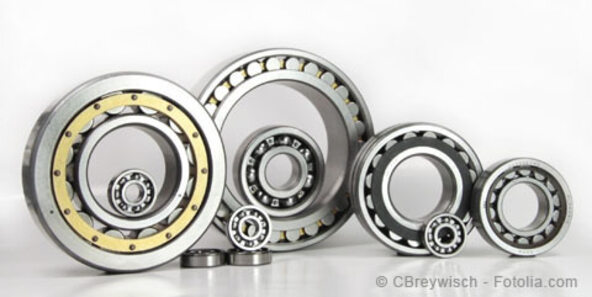Rolling bearing lubrication
Functional principle and types of a rolling bearing
Rolling bearings allow friction-reduced rotary movements between various machine components.
In engineering, rolling bearings are therefore used, amongst others, to guide and support shafts and axles. Rolling bearings are based on the principle of rolling friction: They consists of an inner and outer ring between which rolling elements roll, which can be kept separated by a cage to reduce friction and wear further. Depending on the application and load, different forms, such as ball or rollers, are used as rolling elements. Thanks to the rolling friction arising from their rolling element form, ball bearings are particularly suitable for high rotational speeds, whereas roller bearings are better suitable for high loads.
Tasks of the rolling bearing lubricant
The aim of rolling bearing lubrication is to prevent metal contacting of the rolling and sliding surfaces through a lubricating film, in order to reduce sliding friction in the rolling bearing further. In addition, lubrication of the rolling bearings results in improvement of the wear protection. This avoids damage to bearings, extends the durability of the bearing and increases operational reliability. Further tasks fulfilled by the lubricant in the rolling bearing are, depending on the type of lubricant (oil or grease with corresponding additives), corrosion protection, extraction of heat from the bearing, protection of the bearing against inner and outer soiling, damping of the bearing running noise, as well as support in the sealing effect of bearing seals.
Decision criteria for grease or oil lubrication
Grease lubrication is used at approximately 90% of all rolling bearings. The main advantages of grease lubrication are:
- Low constructional demand
- Good support for sealing of the bearing
- Long periods of use
- Low frictional torque
- Good emergency running properties at solid lubricants
- Good noise-dampening properties
When selected correctly, greases ensure reliable lubrication for a wide range of speeds and loads for all types of bearings with the exception of axial spherical roller bearings.
Structure and characterization of greases
Lubricating greases consist of a base oil that is bound by a thickener. This ensures that the oil remains at the lubricating point. There it ensures effective protection against friction and wear and seals the lubricating point against external influences such as moisture and foreign matter. Greases are therefore ideal for use in rolling bearings. The typical performance characteristics of a grease, such as the drop point, load capacity and resistance to water, are determined by the base oil and the thickener. Improvement of the corrosion and wear protection, load-bearing and adhesive capacity and the resistance to ageing is realized through the additives added to the grease.
Characteristics for selecting a rolling bearing grease
The choice of a rolling bearing grease depends on the design of the rolling bearing and the material of the rolling bearing cage (metal or plastics) as well as the conditions of use and application, such as the application temperature, speed range, pressure load and ambient influences (water, dust or aggressive media). The following data are used to characterize a rolling bearing grease.
1. NLGI grade
At lubricating greases the consistency is the characteristic for assessing the strength of a grease. The classification of greases according to NLGI ranges from very soft (Class 000) to very firm (Class 6). Lubricant greases of the NLGI grades 1-4 are suitable for use in rolling bearings.
2. Drop point (in °C)
The drop point of a lubricant is the temperature at which liquefaction of the grease arises. It lies notably over the recommended operating temperature which at a rolling bearing is determined not only by the ambient temperature, but also be the heat that develops during operation of the rolling bearing in the bearing.
3. Four-ball test rig value
The four-ball test rig is a testing device for lubricants used at high surface pressures. It consists of a rotating moving ball which slides on three fixed balls. During the test for the maximum load-bearing capacity of the lubricant, a test force acts on the moving ball, which is increased in steps until the four-ball system is welded together as a result of the friction heat produced.
4. DN factor (rotating speed factor)
The DN factor specifies up to which maximum rotating speeds a lubricant can be used in rolling bearings. It is calculated from the bearing rotational speed, the mean bearing diameter (in mm) and a factor considering the sliding friction component of the bearing design.
5. SKF-Emcor value
The SKF-Emcor process is used to assess the corrosion protection properties of rolling bearing greases. In the process water is added to the grease and examined for corrosion self-aligning ball bearings with defined running duration, speed and specified standstill periods to DIN 51 802802. If there is no corrosion at the visible inspection of the test rings, the degree of corrosion is 0. At very strong corrosion the degree of corrosion amounts to 5.
Lubrication of rolling bearings
An important prerequisite for high operational reliability of a rolling bearing is the continuous supply with lubricant. The instructions of the bearing manufacturer have to be observed during initial greasing or renewed greasing of the bearings. It has to be filled such that all functional surfaces are certain of being greased. Bearings running slowly (DN value < 50,000) and their housing can be filled completely, high-speed bearings (DN value > 400,000) up to 1/4 of the free space inside the bearing. Otherwise we recommend filling up to 1/3.
Grease-lubricated bearings have sufficient operational reliability if the relubrication intervals are not exceeded. Relubrication is necessary when the grease operating life is lower than the expected bearing operating life. Relubrication is carried out by means of a grease gun or automatic lubrication systems. If possible, relubrication should be carried out during operation. The relubrication quantity lies at 50-80% of the initial filling. If old grease cannot be removed, the quantity of grease should be restricted so as to avoid overlubricating the bearing. If lubrication frequencies tend to be low, you should aim for a full grease change.
Before switching to a different grease sort, clean the rolling bearing thoroughly or respectively relubricate with grease until the old grease has been pressed completely out of the bearing.. In this case the miscibility of the lubricants and the material compatibility has to be tested beforehand.
Back to overview


